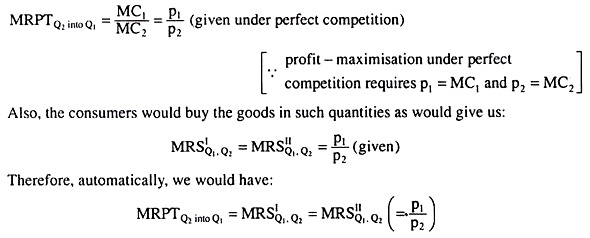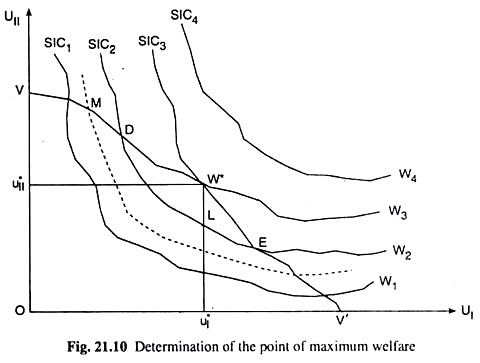In this article we will discuss about whether perfect competition is necessary or not for Pareto optimality and welfare optimum.
Perfect Competition is not Necessary for Pareto Optimality:
Perfect competition is not necessary for Pareto optimality.
Even if perfect competition does not exist, the economy may move from Pareto non-optimality to:
(i) A Pareto-optimal state on the Edge-worth contract curve for production (CCP) through a process of reallocating the factors of production among the products;
ADVERTISEMENTS:
(ii) A Pareto-optimal state on the Edge-worth contract curve for exchange (CCE) through a process of redistribution of the goods among the individuals; and
(iii) To a Pareto-optimal product-mix making the marginal rate of product transformation (MRPT) between the goods (or, the numerical slope of the PPC) equal to the marginal rate of substitution (MRS) between the goods for each individual (or the common numerical slope of the ICs of the two consumers) on the Edge-worth CCE through a process of redistribution of the goods.
Perfect Competition is Sufficient for Pareto Optimality:
Perfect competition, although not necessary, is sufficient for Pareto optimality. Under perfect competition prices of the goods (p1and p2) and those of the factors (r1 and r2) are exogenously given to their buyers (and sellers).
ADVERTISEMENTS:
Therefore, if we assume that the consumers and producers aim at utility and profit maximisation, respectively, then we would have the following:
(i) Each producer would buy such quantities of the factors as would make the MRTS between the factors equal to the ratio of the prices of the factors.
In the process we would have:
i.e., the Pareto-optimality marginal condition for production would be satisfied.
ADVERTISEMENTS:
(ii) Each consumer would buy such quantities of the goods as would make the MRS between the goods equal to the ratio of their prices.
In the process, we would have:
i.e., the Pareto-optimality marginal condition for exchange (or consumption) would be satisfied.
(iii) The producers would decide upon a product-mix for which we would have:
i.e., the Pareto-optimality marginal condition for product-mix would be satisfied.
Perfect Competition is Neither Necessary Nor Sufficient for Welfare Optimum:
Therefore, that perfect competition, although not necessary, is sufficient for Pareto optimality. However, this position does not contradict the proposition that perfect competition is neither necessary nor sufficient for welfare optimum. Let us explain.
ADVERTISEMENTS:
On the basis of the three marginal conditions of Pareto optimality and the Edge-worth contract curves for production and exchange and the PPC of the economy, we obtain a grand utility possibility frontier (GUPF) like the one shown in Fig. 21.10.
The GUPF gives us the maximum possible UII at any given U, or the maximum possible UI at any given UII. Perfect competition is not necessary, but it is sufficient for Pareto optimality, and Pareto optimality conditions are satisfied at every point on the GUPF. Therefore, perfect competition is not necessary, but it is sufficient, for deriving the GUPF.
In order to obtain the point of maximum social welfare—which is also called the point of bliss—we have to superimpose the social indifference contours (SICs) on the GUPF, as we have done in Fig. 21.10.
ADVERTISEMENTS:
Social welfare is maximised at the point of tangency between the GUPF and an SIC. In Fig. 21.10, this point has been obtained to be W*, where the economy is on the highest possible SIC, viz., SIC3, subject to its remaining on the GUPF. At W*, the two consumers are enjoying the levels of utility U*I and U*II respectively.
Now, since welfare optimum occurs at a point on the GUPF, and since perfect competition is not necessary for the derivation of GUPF, we may conclude that perfect competition is not necessary for achieving welfare optimum.
Again, perfect competition is sufficient for Pareto optimality and so, for obtaining the GUPF, but it is not sufficient for welfare maximisation, because any point on the GUPF does not take us to welfare optimum, only the “point of tangency” does.
We may, therefore, conclude that perfect competition is neither a necessary nor a sufficient condition for optimum welfare, although perfect competition is sufficient for Pareto optimality, though not necessary.

